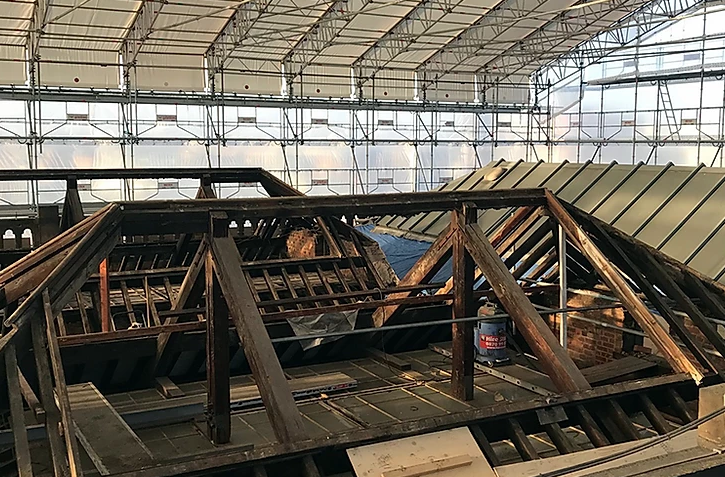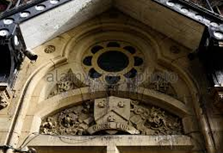Heritage Roofing
Heritage roofing - maintaining our iconic buildings
The UK is home to some of the most iconic buildings in the world, from stunning churches and cathedrals to historic stately homes. Each and every one of these remarkable feats of architecture requires regular maintenance to ensure they remain in the very best condition, allowing them to be enjoyed for generations.
Cathedral Care
Restoration and upkeep of cathedrals
There are some 42 Anglican cathedrals in the UK, not to mention 20 or so Catholic cathedrals. Cathedrals form the most important collection of historic buildings in England. The largest and most ancient are internationally famous, the smallest are usually among the most significant buildings in their region and even the most recent are architectural masterpieces.
Master Craftsmen
Championing our heritage with modern craftsmanship
Twenty years ago, English Heritage (now Historic England) published its first-ever Register of Buildings at Risk across England, which featured nearly 2,000 buildings and monuments that were ‘neglected, broken and unloved’. Recently Historic England was delighted to announce that over two-thirds of those buildings were now safe, in both urban and rural areas right across the country.
Traditional Lime
Lime: it’s better for buildings – and for the environment
It is now fairly well known that cement is not good for old buildings and that lime mortar should be used. But why? What are the advantages and what are the disadvantages? In order to begin to answer those questions it is necessary to understand the nature of traditional building, the process by which buildings used to be built, and how it differs from modern construction, the process by which we build today.
Audio Visual
Audio visual equipment in church buildings
This guidance is issued by the Church Buildings Council under section 55(1)(d) of the Dioceses, Mission and Pastoral Measure 2007. As it is statutory guidance, it must be considered with great care. The standards of good practice set out in the guidance should not be departed from unless the departure is justified by reasons that are spelled out clearly, logically and convincingly.
Read More...
CRE Events
Exhibitors enthuse over the CRE experience
By 4pm on the first day of CRE 24 at the Marshall Arena in Milton Keynes, exhibitors Chris and Kim Dunphy had already had so many helpful and detailed conversations with visitors that they were “completely talked out”.
Insurance
You need to ensure that reasonable precautions are in place at your church to keep it safe for those who use it. To do this, you need to think about what might cause harm to people.
You will then need to decide if the precautions already in place are adequate. If they are not, you may need to identify further action to prevent any danger. When done formally, this is known as a risk assessment.
Church Maintenance
Church maintenance and repair: Calendar of Care
Just as prevention is always better than cure, maintenance is preferable to major repairs. But, such repairs may not always be avoidable. Church Care offers a monthly guide in our coming issues Starting in Spring
We can help you understand the common problems and areas that need your special attention, and give you tips for regular maintenance schemes.
Pest Control
Michael Palin warns of pest threat to churches
Michael Palin is supporting the future of the UK’s historic churches and chapels with a voiceover for a new animated film. The 80 second animation, produced for the National Churches Trust, highlights why churches are some of the nation’s best loved buildings.
Town Halls
The history of the great Victorian Town Halls of Northern England
From industrial squalor to civic pride, the story behind some of the most impressive buildings of the North involve a unique mix of economics, grand designs and noble sentiments within communities.
Lead Roofing
Lead is one of the oldest materials in the roofing industry and is still commonly used throughout the world today.
Lead roofing is a traditional roofing method which has been used in the industry for hundreds of years, and is therefore proven to be extremely reliable. Lead roofing, and sand-cast lead, in particular is ideal for old buildings such as churches or historical renovations, whereas milled lead roofing is a mass-produced alternative, used for precision and accuracy in homes and commercial buildings alike.
Lightning Protection
When lightning strikes are you protected against this act of God?
The issue of lightning protection in churches is one that has exercised this publication for many years. In this four-part series of spotlights on the issue we will be revisiting various aspects of the subject, beginning with an overview of current thinking.
SEARCH OUR DIRECTORY
Best-Selling Crematorium Furniture
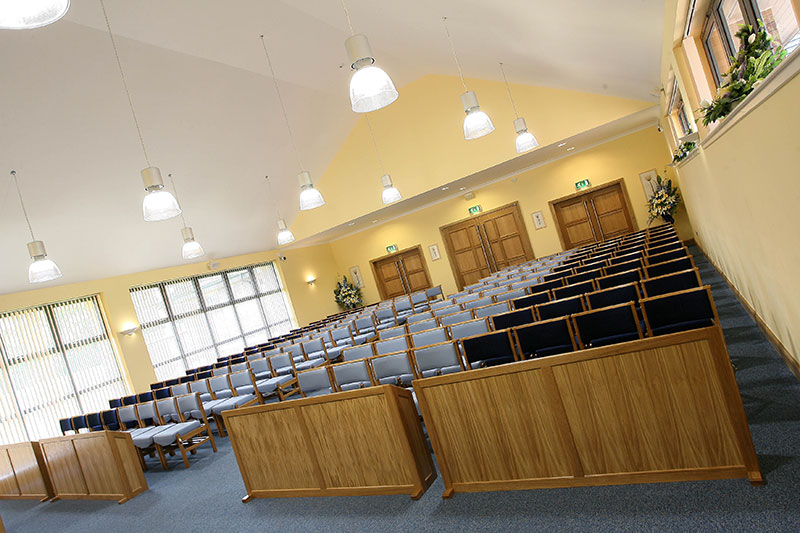 Rosehill are often the contract furniture supplier of choice for the bereavement and crematorium sector. We’ve been supplying quality furniture to funeral directors across the UK for over 3 decades offering a wide selection of seating and bespoke sanctuary items.
Rosehill are often the contract furniture supplier of choice for the bereavement and crematorium sector. We’ve been supplying quality furniture to funeral directors across the UK for over 3 decades offering a wide selection of seating and bespoke sanctuary items.
This blog post covers our best-selling items for crematoriums making it easier for you to choose and order your furniture with Rosehill.
CRE Stories
Audio visual equipment in church buildings
 One recent challenge for DM Music Ltd was undertaking a complete overhaul of the audio system at Guildford Cathedral. This has been part of the Cathedral’s repair work with significant proportion of funding from the Heritage Lottery Fund.
One recent challenge for DM Music Ltd was undertaking a complete overhaul of the audio system at Guildford Cathedral. This has been part of the Cathedral’s repair work with significant proportion of funding from the Heritage Lottery Fund.
The three main challenges for the DM team were to:
- Offer high intelligibility for the spoken word in a large and reverberant space.
- Install a discreet but capable audio system that’s architecturally sensitive.
- Give simplicity in use for regular operators but with flexibility for special events and external groups.
Through careful design, installation and commissioning DM Music have combined technology and experience to deliver a system that goes beyond the requirement. Ultra discreet, high performance speakers, wireless iPad control, digital audio distribution and processing have all played a part in enabling them to deliver a system suited to the Cathedral’s needs, now and for the future.
The key equipment used comprised K-Array discreet speakers and subwoofers, Yamaha MTX Audio Processors and Crestron control / iPad control.

For further information visit www.dmmusic.com
The ‘family GP’ for your church
 What are Quinquennial Inspection Reports?
What are Quinquennial Inspection Reports?
Under the Inspection of Churches Measure 1955, as amended by the Care of Churches and Ecclesiastical Jurisdiction Measure 1991, all consecrated buildings of the Church of England must by law be inspected once in every five years by a registered architect or chartered building surveyor (the ‘Quinquennial Inspector’ or QI) who is approved by the Diocesan Advisory Committee (DAC). Most other denominations and many secular organisations which are responsible for historic buildings now adopt a similar approach to inspections.
Surrey based chartered surveyors Chawton Hill Associates summarise ChurchCare’s guide on selecting a QI as follows:
- The professional should be suitably qualified and ‘whose training, accreditation and experience in buildings conservation corresponds with the complexity and significance of the church building’
- If your church is listed (Grade 1 or 2) or classified by the Church Buildings Council as a Major Church, the QI should have demonstrable experience of work with buildings of that listing grade
- The person should take time to understand the needs and vision of the parish
- Any potential QI should be invited to visit the church and meet members of the PCC or fabric sub-committee before appointment
- Inviting 3 candidates to review is good procurement practice
- You should check the value of the QI’s professional indemnity insurance (bearing in mind that £250,000 for each claim is a good minimum)
- Check the QI’s report format covers the repair of the building, maintenance, sustainability, safety of the structure, unsafe floors and access
- Where issues are identified check these will be graded according to the urgency of the repair:
A – Urgent, requiring immediate attention
B – Requires attention within 12 months
C – Requires attention within the next 18 – 24 months D – Requires attention within the quinquennial period
D – Requires attention within the quinquennial period
E – A desirable improvement with no timescale
M – routine items of maintenance
Chawton Hill Associates will be attending this year’s CRE show at Sandown Park in Surrey - Stand S108 (just follow the signs towards Cindy’s Bar at the opposite end of the hall from the main entrance) where you will find information on their extensive ecclesiastical experience and details of their Quinquennial Inspection Report ‘CRE Show’ special offer.
For further information visit www.chawtonhill.com/quinquennial-inspection-reports
CAVS install new AV system 'seamlessly' at St James Church, Trowbidge
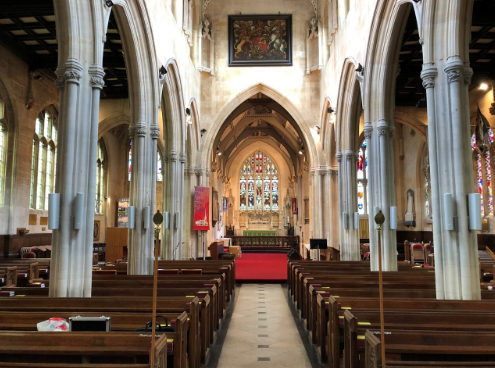
Creative Audio-Visual Solutions (CAVS) are a dedicated church audio and visual supplier working throughout the UK.
The Hertfordshire-based company were recently commissioned to install a new audio and visual system into the Parish Church of St James in Trowbridge. The brief was to ensure that that all new equipment fitted seamlessly into the environment whilst providing the latest technologies for full range worship and advanced multimedia display.
The visual system consists of 3 discreet winched projection screens which hide behind the arches when not in use. These utilise 7,500 and 5,000 projectors for the highest image quality across all sources from words to pictures and video. An HD motorised camera was installed – allowing close-ups of activities to be projected as well as providing the means to record and stream services online. Flexible HDMi connectivity was installed for laptop and ‘comfort’ monitor connection.
The audio system features 12 column array speakers to fit with the pillar décor – sublimated with 2 subwoofers to provide true full range sound amplification. A digital matrix processor ensures the audio system is fully tuned to the room and the likeliness of feedback and other acoustic anomalies is virtually eradicated. A digital mixer with wireless iPAD control was installed allowing for all types of operator and the simple recall for different types of service at the touch of a button. A portable digital stagebox provides up to 16 instrument inputs at the platform for a large worship band.
New radio microphones were installed along with audio playback (including Bluetooth connectivity) and recording systems. Finally, the system equipment was installed within a bespoke console - utilising parts of the church pews to marry effortlessly with the building's aesthetics.
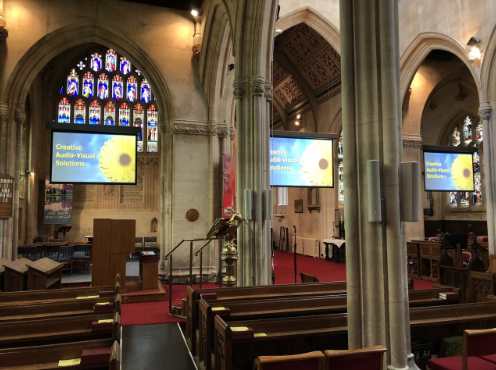

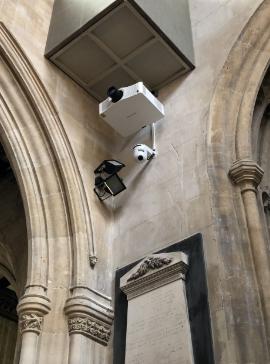

For an onsite consultation or for advice on the right equipment for your church call and see CAVS at CRE Sandown, Stand S152 or email: This email address is being protected from spambots. You need JavaScript enabled to view it. Local references are available upon request. ‘Like’ them on Facebook (cavsolutions) for the latest installation case studies and product news or visit www.cavsolutions.co.uk
Church furniture specialists provide a Finer product
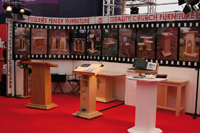 Fullers Finer Furniture is based in Weston-super-Mare, Somerset and was established in 1985. From humble beginnings they now design and manufacture church furniture on a national basis. Although they offer furniture both commercially and for the home, it is church furniture that they specialise in. From bespoke items to the award winning gas height adjustable Canterbury Lectern, right through to restoration work and complete reordering of church furniture, Fullers provide a high quality comprehensive service with distinctive attention to detail.
Fullers Finer Furniture is based in Weston-super-Mare, Somerset and was established in 1985. From humble beginnings they now design and manufacture church furniture on a national basis. Although they offer furniture both commercially and for the home, it is church furniture that they specialise in. From bespoke items to the award winning gas height adjustable Canterbury Lectern, right through to restoration work and complete reordering of church furniture, Fullers provide a high quality comprehensive service with distinctive attention to detail.
The award winning Canterbury Lectern and its big brother The York Lectern are gas height adjustable to suit the needs of any congregation. With its stylish design it comes in a number of finishes including oak, ash, beech, mahogany and maple.
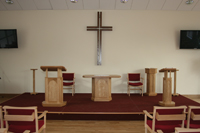 Fitted with microphone sockets and the option of an LCD video monitor these fine portable lecterns will fit perfectly into any type of church building.
Fitted with microphone sockets and the option of an LCD video monitor these fine portable lecterns will fit perfectly into any type of church building.
They are also able to design and make to order communion tables, fonts, A/V cabinets, table top lecterns, choir frontals, communion rails, flower stands and much more.
You can see a video demonstration of the Canterbury and York Lectern's by clicking here.
www.fullersfinerfurniture.co.uk
Ancient and modern: hi-tech AV company returns to CRE
The unique blend of ancient buildings and the latest technology that epitomises the modern church will be in evidence once more at the International Christian Resources Exhibition at ExCel in May in the persons of audio-visual specialists DM Music and installation division DM Installation Projects.
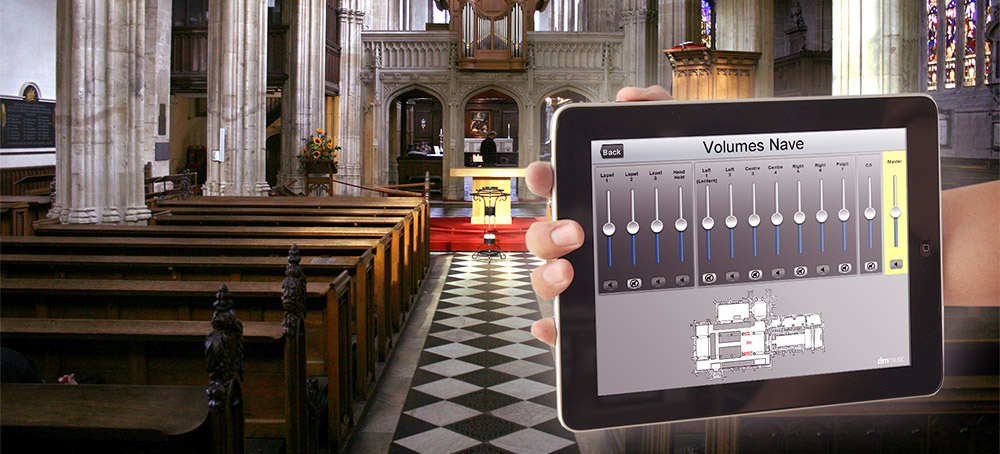
The company will be presenting some of the latest audio-visual technologies particularly suited to church use, which this year will include iPad touch screen control systems from Crestron that allow complete wireless control of audio, including level control in different zones, remote audio playback and recording. Primarily, the systems allow for very simple operation of complex systems; but they also offer huge flexibility and lots of possibilities for system expansion in the future.
It’s not just audio, either; the systems can control electric screens, projectors, lighting, heating – you name it. Simple accessible control is just a fingertip away, anywhere in the church building.
As well as an installation in Wakefield Cathedral, DM recently completed a full sound system at the University Church of St Mary the Virgin in Oxford: part of a £5.5m restoration of the historic church which saw the final sermon of Thomas Cranmer prior to his burning at the stake in 1556 and the launch of the 19th-century Oxford Movement by John Henry, later Cardinal, Newman.
The system includes a number of very discreet K-Array speakers and complete iPad control via a Crestron System. Such a success was the installation that the director of DM Music and DM Installation Projects were invited to the official re-opening service.
For more information visit www.dmmusic.com
Illuminating - another stunning church project from Lighting Dynamics
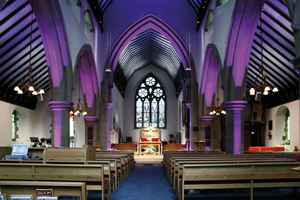 Lighting Dynamics UK (incorporating Ecclesiastical Lighting), based in Sutton Coldfield, West Midlands, continue their development as one of the UK’s premier companies specialising in the interior and exterior illumination of cathedrals, churches and other places of worship.
Lighting Dynamics UK (incorporating Ecclesiastical Lighting), based in Sutton Coldfield, West Midlands, continue their development as one of the UK’s premier companies specialising in the interior and exterior illumination of cathedrals, churches and other places of worship.
The company is dedicated to offering a totally independent, creative and unbiased lighting design and consultancy service and, where required, they can supply all of the associated specified lighting equipment.
Lighting Dynamics has a long established reputation for creating practical and architecturally sympathetic lighting schemes. Wherever possible, discreet lighting equipment is specified and installed to produce suitable levels of task and ambient illumination and to highlight both ecclesiastical features and any special architectural details.
Their comprehensive range of modern, energy saving, long life lighting equipment is manufactured from the highest quality materials and takes into consideration many important factors such as reliability, durability, optical performance, overall efficiency, size, style and ease of maintenance, to name but a few.
The company is just about to launch a brand new family of the very latest bespoke LED fittings, specially designed for all types of ecclesiastical lighting tasks. This range of products has been under development for some considerable time and takes their overall lighting portfolio to the next level of technical innovation.
Lighting Dynamics also has an unrivalled knowledge and expertise of all modern intelligent dimming and lighting control systems.
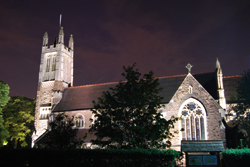 Lighting Dynamics has a significant number of very prestigious church lighting projects currently in progress with a large number at advanced stages of planning and design.
Lighting Dynamics has a significant number of very prestigious church lighting projects currently in progress with a large number at advanced stages of planning and design.
Company founder, Gerry Browne commented: “This is a very exciting time in the further development of church lighting, especially with such a great and diverse range of modern light sources now coming on stream.”
He has found that customers are increasingly looking for a company with the flair and experience to provide a quality lighting design, whilst also specifying top grade lighting equipment and controls that will give longevity, reliability and overall flexibility for their ecclesiastical projects.
Gerry continued: “In the main, clients no longer wish to see their church lighting project looking like an extension of somebody else’s lighting showroom or lit with industrial style floodlights to resemble a railway marshalling yard. It can be a dedicated process which involves advising, informing and demonstrating what can be achieved.”
Lighting Dynamics has, if required, a fully qualified team of NIC EIC registered electricians able to carry out the installation of interior and exterior lighting systems to current electrical standards and regulations.
The company covers all of the UK and Ireland and provides a bespoke service for each individual church lighting project, from initial meeting right through to final focusing and commissioning. In Gerry’s words “Lighting Dynamics UK can provide the ultimate lighting service.”
Recently completed lighting design and supply projects include:
• St Wulfram’s Church, Grantham – one of the finest magnificent medieval churches in England.
A phased interior lighting upgrade including the latest ceramic halide and low volt tungsten light sources linked to analogue lighting control systems.
 • All Saints Church, Daresbury – a beautiful parish church set deep in the Cheshire countryside only a few minutes from Warrington. The church is well known for its connection with the Alice in Wonderland author Lewis Carroll.
• All Saints Church, Daresbury – a beautiful parish church set deep in the Cheshire countryside only a few minutes from Warrington. The church is well known for its connection with the Alice in Wonderland author Lewis Carroll.
As well as the complete interior lighting upgrade, the stained glass Lewis Carroll Memorial Windows (a must for visitors) have also been feature illuminated by new externally placed luminaires. A comprehensive lighting control / dimming system allows maximum flexibility.
• St George’s Church, Poynton, Cheshire – located between Stockport and Macclesfield, St George’s is positioned at the heart of the village and was built in the Victorian Gothic style.
Complete interior lighting upgrade incorporating colour change LED light sources linked to a DMX lighting control system.
• St Augustine of Hippo Church, Edgbaston, Birmingham – The building in a geometric Gothic style has numerous stone carvings and a striking painted chancel ceiling and is an outstanding Victorian landmark.
Complete interior lighting upgrade including the latest ceramic halide, LED and low volt tungsten light sources linked to analogue lighting control systems.
• St Michael and All Angels Church, Penkridge – A collegiate parish church set in a beautiful Staffordshire village.
Complete interior lighting upgrade including the latest ceramic halide and low volt tungsten light sources linked to analogue lighting control systems.
• St Agnes Church, Moseley, Birmingham – Sited on an island location in the heart of the beautiful conservation area of Moseley.
Exterior lighting upgrade of tower and four main elevations of the building utilising the latest ceramic halide and tungsten light sources housed in modern IP 68 rated in-ground recessed luminaires.
• Holy Trinity RC Church, Sutton Coldfield – A more modern style building with high arched windows and a beautiful wooden ceiling reminiscent of the ceiling depicted in Leonardo Da Vinci’s The Last Supper.
Interior and exterior lighting upgrade linked to complete lighting control.
Electrical installation of all of the above projects has been carried out by the Birmingham based NIC EIC registered electrical contractors A J Electrics (Coleshill) Ltd.
• For further information about Lighting Dynamics UK please visit www.lighting-dynamics.co.uk
Full sound and visual system for Somerton St Michael and All Angels Church
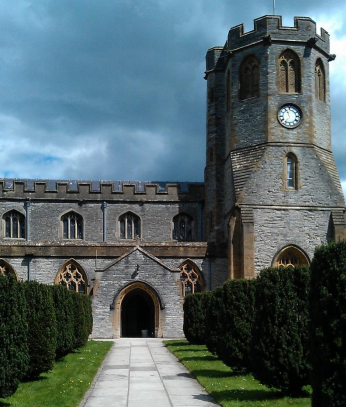 The church of St Michael and All Angels is reputed to be an abbey church, and has existed adjacent to the market square in the old county town of Somerton, since circa 1100. So it was doubtless with some trepidation, that the PCC embarked on a major refurbishment for the church interior.
The church of St Michael and All Angels is reputed to be an abbey church, and has existed adjacent to the market square in the old county town of Somerton, since circa 1100. So it was doubtless with some trepidation, that the PCC embarked on a major refurbishment for the church interior.
This involved replacing the floor and heating systems, rewiring and roof cleaning, a glass partition door for the south transept and a comprehensive sound system with video distribution to facilitate more flexible use of the building. API Communications were contracted to provide a full sound and visual system to meet all needs of the church.
From full frequency audio support for either a simple morning service, or full performance by musicians/singers. As well as ensuring that the solution was not out of place in a church of this age.
The sound and visual systems were designed by API Communications to meet the needs of the customer. We chose a 28 channel Allen+Heath mixing desk to control the audio sources as this is a reliable well laid out product, and a Behringer Digital graphic equaliser to provide a natural sounding flat frequency response, and a calculated delay for the rear group of the 12 loudspeakers fitted within the church.
A pair of 15” active subwoofers complemented the acoustics of our column speakers, resulting in full range reproduction, delivering excellent speech intelligibility and rich musical reproduction. The whole result is most pleasing acoustically, with many complimentary remarks so far received.
The entire audio and visual system hardware is encompassed within a custom piece of furniture, which was then clad with Oak so as to resemble the pews alongside it at the rear of the nave.
It was a given requirement of both the PCC and the Clergy that there should be the potential for the congregation to view images from PowerPoint, or DVD sources, from anywhere within the church. But with Projectors and screens having been ruled out as too intrusive visually, for this church, we installed a network whereby computer signals, video and Audio could be reproduced at a choice of 12 positions within the nave and chancel. LED display screens, fitted to trolley mounts, are then positioned at the chosen points within the nave to cover the congregation anticipated for each service.
Additional points adjacent to each doorway enable the congregation to “overspill” outside the building and yet still be involved in the service within, and a discreet camera enables all assembled to enjoy the view of a wedding procession as it moves through the nave.
As a whole this system enables the building to be most flexible with regard to the many disparate roles for which a modern church building must be equipped.
Summary
A bespoke system, providing an appropriately camouflaged audio and visual system that enables the church to do the following:-
- Full frequency audio support for a morning service
- Full performance by musicians/singers/choir
- Ability to play PowerPoint slides, films or dvds unobtrusively from anywhere in the church
- Any overspill to the congregation outside the church can still be involved in the service through the use of the additional points that were set up
- The ability to now see the whole of the wedding procession through the use of a discreet camera
Testimonials
The Bath and Wells Diocesan Advisory Committee
“The Committee noted that this proposed installation will be a sophisticated, comprehensive and flexible system to enable full and up-to-date audio visual facilities within the main areas of the church. The proposal is well described technically.”
Alan at Somerton
“API have provided an excellent service throughout the design and installation, careful, neat, and considerate installers who have given us what we want. We are using the system with confidence having been given full instructions regarding its use and knowing that if we meet any problems API are always on hand to answer our questions and to offer advice.”
For further information visit www.apicommunications.co.uk
A lighting requirement? One church's perspective
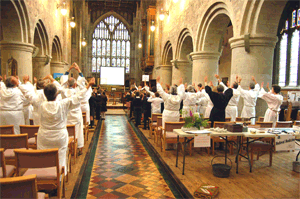 Considerations other than cost need to be made when engaging a contractor for a church lighting project.
Considerations other than cost need to be made when engaging a contractor for a church lighting project.
Anthony J Smith (Gloucester) Ltd has recently completed a project to install new lighting throughout Great Malvern Priory which is part of the Greater Churches Network. The priory is a Grade I listed building and is a focal point both in Malvern and in the Diocese of Worcester.
 The priory receives over 30,000 visitors each year and has a large worshipping congregation. Services are held every day of the year and the building is extensively used by the local community. The challenge was to replace the 1960's lighting with a new energy efficient, low maintenance lighting installation, suitable for the many and varied activities that take place in the building, while minimising the disruption during the installation period.
The priory receives over 30,000 visitors each year and has a large worshipping congregation. Services are held every day of the year and the building is extensively used by the local community. The challenge was to replace the 1960's lighting with a new energy efficient, low maintenance lighting installation, suitable for the many and varied activities that take place in the building, while minimising the disruption during the installation period.
A wide-ranging exercise was carried out by the Priory's Lighting Project Group to determine the requirements for the new lighting, including visiting several other churches with new lighting installations. The result was the production of a Design Brief that specified the various lighting requirements, and ensured that the primary purpose of the building as a place of worship was not lost in a desire to illuminate the features of the building.
 The group considered employing separate lighting design consultants and installation contractors, but chose instead to seek a company that was capable of handling the whole process including both design and installation.
The group considered employing separate lighting design consultants and installation contractors, but chose instead to seek a company that was capable of handling the whole process including both design and installation.
Proposals based on the Design Brief were received from three companies who offer a lighting design and installation service, and Anthony J Smith (Gloucester) Ltd was subsequently appointed. Anthony J Smith was formed in 1972 and specialises in lighting church and ecclesiastical buildings.
The new lighting installation was designed by Neil Blake, director of Anthony J Smith, and incorporated energy efficient, high performance, low maintenance equipment. The design followed the Design Brief and provided for the different uses of the building including highlighting various building features for visitors, lighting for performances in various locations, and an all-important, even, non-directional layer of light through the building for services and other activities.
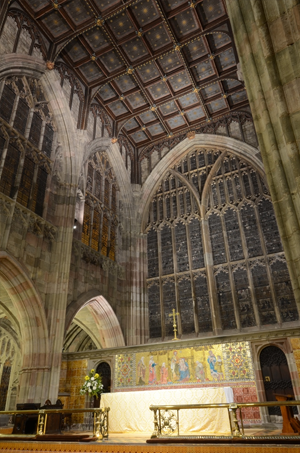 Neil was also involved in many detailed discussions with the Lighting Project Group and the approving authorities including the Diocesan Advisory Committee, English Heritage and the priory architect. As the design was refined, Anthony J Smith offered technical support and demonstrations of the effects available by using different types of light fitting.
Neil was also involved in many detailed discussions with the Lighting Project Group and the approving authorities including the Diocesan Advisory Committee, English Heritage and the priory architect. As the design was refined, Anthony J Smith offered technical support and demonstrations of the effects available by using different types of light fitting.
The installation was completed by Anthony J Smith's own experienced and qualified engineers in a series of localised areas which allowed normal Ôchurch life to continue with the minimum of disturbance. Working hours and break-times were varied to suit the services, weddings and funerals scheduled for each week, and the installation was carried out with considerable attention to detail and care in concealing the cables.
The new priory lighting has been received with great excitement by both the regular congregation, who can now clearly see their hymn books, and by visitors who marvel at the ceilings and other features that had not previously been visible.
Michael Angling, the priory project manager, commented: "This was an excellent example of the contractor and client being flexible to the needs of each other which allowed the project to be brought to a very satisfactory conclusion".
The staff at Anthony J Smith (Glos)Ltd are an as experienced team as can be found working in this niche market. They have been involved in the designing and installing of tailored lighting solutions in many of our fine listed buildings both large and small for a very long time. There is no substitute for experience when dealing with these most important buildings and a good design is only half of the challenge. A sensitive installation of cabling is also of utmost importance as many Church interiors are spoilt by an untidy and unsuitable installation of cabling. Value for money and use of suitable technologies for the exacting needs of each individual Church should also be established at every stage of the project.
For more information about this and other projects visit www.anthonyjsmith.co.uk
Lighting Dynamics complete another stunning church lighting project
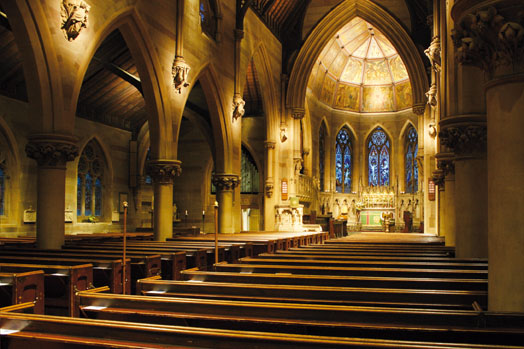 Lighting Dynamics UK, based in Sutton Coldfield, West Midlands, has recently designed and completed the installation of yet another stunning lighting project for the magnificent and sumptuous interior of St Augustine of Hippo Church in Edgbaston, Birmingham.
Lighting Dynamics UK, based in Sutton Coldfield, West Midlands, has recently designed and completed the installation of yet another stunning lighting project for the magnificent and sumptuous interior of St Augustine of Hippo Church in Edgbaston, Birmingham.
St Augustine's, a Grade II* building, has been a splendid Victorian landmark at the centre of the Conservation Area that bears its name since the church was first consecrated in 1868.
Gerry Browne of Lighting Dynamics said: 'The interior lighting upgrade at St Augustine's provided a real challenge, especially in terms of the correct type and levels of illumination for both the church's magnificent architectural and ecclesiastical features.'
Working closely with key members of the PCC, the DAC, the Church Architect, English Heritage and Birmingham Victorian Society, Gerry worked through all of the details and a final lighting design solution evolved.
The final lighting design included a variety of all modern, long life and energy saving light sources including LEDs, ceramic metal halide and low voltage tungsten, all of which are linked to a unique and bespoke dimming / lighting controls system.
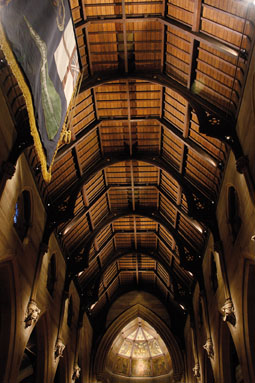 These light sources are linked to a quality range of appropriate architectural light fittings all with the correct optics and the ability to take a complete range of lighting accessories, such as anti glare louvres, spread lenses, etc.
These light sources are linked to a quality range of appropriate architectural light fittings all with the correct optics and the ability to take a complete range of lighting accessories, such as anti glare louvres, spread lenses, etc.
The client and all of the project team are delighted with the final result and a grand opening ceremony by the Lord Mayor of Birmingham has already taken place.
Lighting Dynamics continue to offer a totally independent, creative, unbiased lighting design and consultancy service and, where required, the supply of all associated/specified lighting equipment.
The company can also provide a complete electrical installation service via a dedicated team of NIC EIC registered electricians.
They have a number of very prestigious church lighting projects currently in progress with a further significant number at advanced stages of planning and design.
Gerry Browne believes that this is a very exciting time in the further development of church lighting, especially with such a great and diverse range of modern light sources now coming on stream.
He has found that customers are increasingly looking for someone with the flair and experience to provide a quality lighting design, whilst also specifying top grade lighting equipment and controls that will provide longevity and reliability for their particular project.
For more from this company visit www.lighting-dynamics.co.uk
New improved lighting at St John the Baptist
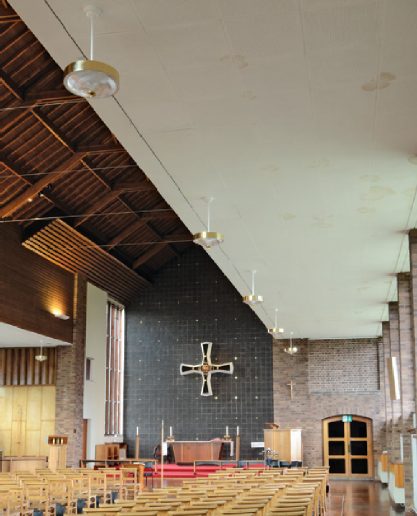 WHEN the Parishioners of St John the Baptist Parish Church in Longbridge decided that the existing lighting was in need of rejuvenation, church lighting design and installation specialists Anthony J Smith (Gloucester) Ltd were invited to discuss the needs and requirements for this vibrant community church.
WHEN the Parishioners of St John the Baptist Parish Church in Longbridge decided that the existing lighting was in need of rejuvenation, church lighting design and installation specialists Anthony J Smith (Gloucester) Ltd were invited to discuss the needs and requirements for this vibrant community church.
The original lighting system was becoming increasingly difficult to maintain and a greater degree of energy efficiency and increased lighting levels, together with a flexible switching arrangement were needed for the various liturgical and community activities that take place within the church.
A number of solutions were discussed with and demonstrated to the PCC and a bespoke borosilicate glass pendant was developed and manufactured.
The compact fluorescent lamps within the pendant are controlled through high frequency electronic dimmable control gear which allows them to be smoothly dimmed down to 10 per cent of their maximum output, whilst providing an expected life of 15,000 hours which equates to 15 years should the lighting be used for 20 hours per week.
The pendants combined with additional nave uplighting, new lighting for the Chancel, increased lighting levels for performances at the front of the nave and with all the switches located in one position, now allow for maximum flexibility in both lighting levels and ambiance.
Gordon Mills, the buildings fabric officer writes: “On behalf of the Parochial Church Council, we are very pleased with the new lighting system. The nave uplighting has introduced a new dimension into the Church which is appreciated by the congregation as is the enhanced lighting within the sanctuary. The work to install the new system was carried out in a very neat and professional manner”
For more information visit www.anthonyjsmith.co.uk
School’s light shines forth once more
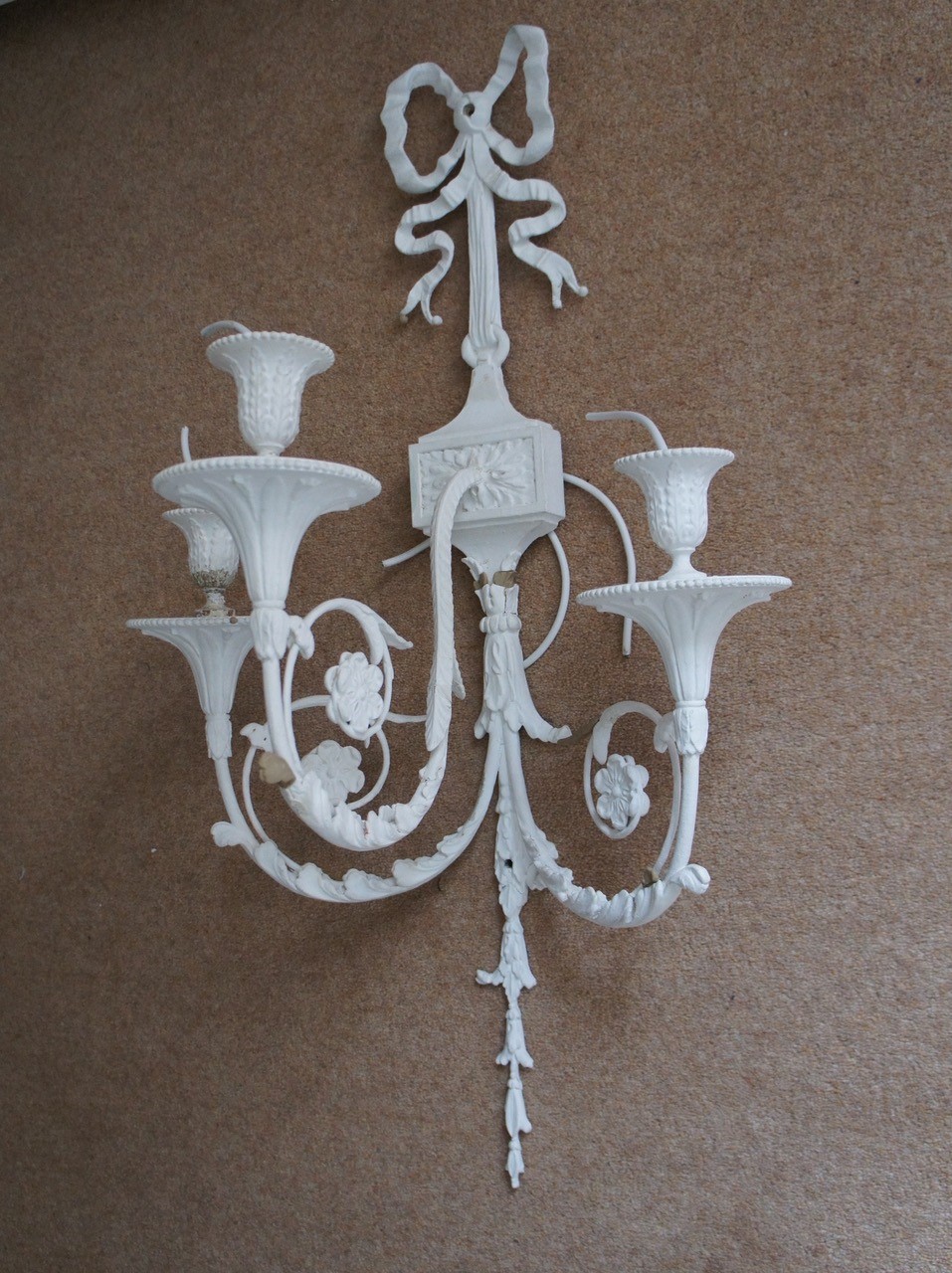 Hatherop Castle, near Cirencester in Gloucestershire, dates from the late-16th or early-17th century. The present building was partially rebuilt by the architect Henry Clutton between 1850-1856 for the Baron de Mauley.
Hatherop Castle, near Cirencester in Gloucestershire, dates from the late-16th or early-17th century. The present building was partially rebuilt by the architect Henry Clutton between 1850-1856 for the Baron de Mauley.
At the end of World War Two it was leased from then-owners the Bazley family by the Owlstone Croft School of Cambridgeshire – becoming the Hatherop Castle School. The buildings were subsequently purchased from the family in 1972. The school remains a private boarding school for 2-13 year olds.
New roof tiles allow new life for former church
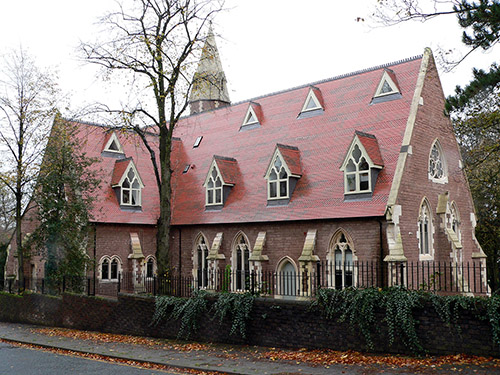 A Grade Two*-Listed neo-Gothic former church in Birmingham has proved to be a shining example of how sensitive restoration and conversion can allow treasured buildings to be brought back into use.St James’s Church in Edgbaston was built in 1852 to a design by the eminent Victorian architect SS Teulon.
A Grade Two*-Listed neo-Gothic former church in Birmingham has proved to be a shining example of how sensitive restoration and conversion can allow treasured buildings to be brought back into use.St James’s Church in Edgbaston was built in 1852 to a design by the eminent Victorian architect SS Teulon.
It had been unused since 1975, becoming derelict and subject to vandalism, theft and decay.
Heating breakdowns require prompt action
 When the heating boiler at the Greek Orthodox Cathedral in Birmingham failed a few days before Christmas, the cathedral authorities called on Stoke-on-Trent heating specialists Mellor and Mottram to carry out the installation of a replacement.
When the heating boiler at the Greek Orthodox Cathedral in Birmingham failed a few days before Christmas, the cathedral authorities called on Stoke-on-Trent heating specialists Mellor and Mottram to carry out the installation of a replacement.
The Greek Orthodox Cathedral in Birmingham was established in 1980 in a former Catholic church, designed by J A Chatwin in 1873. It is dedicated to the Dormition of the Theotokos – the ‘falling asleep’ of the Mother of God – and to St Andrew.
The art of terracotta
 Darwen Terracotta offer a fascinating insight into their process - from site survey, to terracotta and faience production, through to delivery and logistics. The company has the specialist skills required to design, match and produce terracotta to the highest quality.
Darwen Terracotta offer a fascinating insight into their process - from site survey, to terracotta and faience production, through to delivery and logistics. The company has the specialist skills required to design, match and produce terracotta to the highest quality.
"Generations of dedicated artisans have passed on their knowledge and experience which enables us to continue providing the best quality and service to our customers. The manufacturing process has changed little over time, though we combine our skills and experience with the latest modelling, casting, drying and kiln firing technology.
Eshton Hall restoration shortlisted for RICS Awards 2018
 The restoration works at Eshton Hall which were carried out throughout 2017 have been short-listed for the RICS Awards 2018 – Yorkshire & Humber in the Building Conservation Category.
The restoration works at Eshton Hall which were carried out throughout 2017 have been short-listed for the RICS Awards 2018 – Yorkshire & Humber in the Building Conservation Category.
Grade II* Listed Eshton Hall has existed on these grounds in North Yorkshire for hundreds of years, possibly as far back as 1200’s. Situated on the outskirts of Gargrave in North Yorkshire, the main hall was burnt to the ground in late 1500’s with the new main building and its impressive tower built in early 1600’s.
Need help finding a good gutter installer?
 Rainclear, the UK’s leading stockist and online retailer of metal rainwater systems, are offering to help customers find a quality gutter installer for their build or renovation project.
Rainclear, the UK’s leading stockist and online retailer of metal rainwater systems, are offering to help customers find a quality gutter installer for their build or renovation project.
They are already known for the offering customers extra by working out the ‘flow calculation’ based on the house design and location, recommending the required size of the guttering/downpipes for efficient management of the rainwater, creating a complete list of the rainwater system components illustrated on the architect’s drawings - A ‘take off’ and providing a competitive quote.
Dorothea Restorations complete conservation of new gaol gates at Wapping Wharf
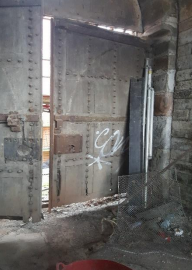 As part of the regeneration of Bristol’s Wapping Wharf, Dorothea Restoration has now completed the conservation of the new gaol gates which stand at the southern end of the site. The Grade II listed Gatehouse is to form a new pedestrian path to lead into this interesting and vibrant site of new homes and businesses.
As part of the regeneration of Bristol’s Wapping Wharf, Dorothea Restoration has now completed the conservation of the new gaol gates which stand at the southern end of the site. The Grade II listed Gatehouse is to form a new pedestrian path to lead into this interesting and vibrant site of new homes and businesses.
NFTMMS member renovates historic ceramic mosaic floor at major stately home
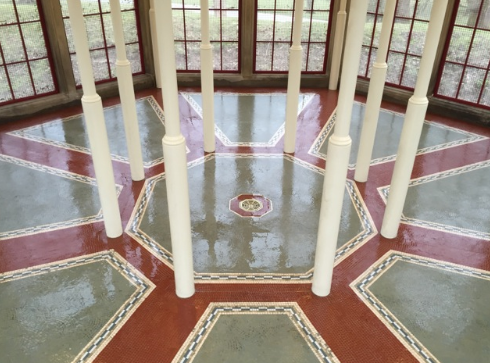 Restoring the historic ceramic mosaic floor in the game larder at one of the UK’s leading historic houses has been undertaken by National Federation of Terrazzo, Marble and Mosaic Specialists (NFTMMS) member JW Restoration.
Restoring the historic ceramic mosaic floor in the game larder at one of the UK’s leading historic houses has been undertaken by National Federation of Terrazzo, Marble and Mosaic Specialists (NFTMMS) member JW Restoration.
According to Federation spokesperson Brian James, this exemplifies the quality of the skills and craftsmanship of NFTMMS members which can produce the most spectacular results.
ISCEx 2018: full details announced
 Details have been released of the programme for this year’s ISCEx – the annual exhibition and networking event hosted by the Institute of Sound and Communication Engineers.
Details have been released of the programme for this year’s ISCEx – the annual exhibition and networking event hosted by the Institute of Sound and Communication Engineers.
ISCEx 2018 will be held on 6-7 March at Coombe Abbey in Warwickshire and will provide excellent opportunities to learn, engage and discuss commercial audio solutions in an intimate, non-imposing environment.
Another brick in an historic Yorkshire wall – 50 years later
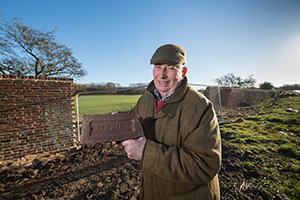 A leading Yorkshire brickmaker is currently helping to rebuild an historic two-mile estate wall near York.
A leading Yorkshire brickmaker is currently helping to rebuild an historic two-mile estate wall near York.
The award-winning York Handmade Brick Company, based at Alne, near Easingwold, is restoring the iconic Allerton Park estate wall - 50 years after chairman David Armitage helped to repair the very same wall.
York Handmade is working with Keighley-based building contractor R N Wooler to deliver the project.
Lost wall paintings restored at Church of the Sacred Heart, Caterham
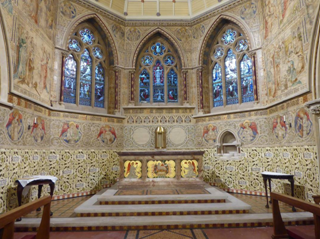 The Church of the Sacred Heart, Caterham, Surrey contains a significant scheme of wall paintings by Joseph Aloyisius Pippet (1840-1903) executed for the Hardman Company between 1890 and 1892. Over the years they had become damaged by water ingress, movement of soluble salts, abrasive cleaning, modern varnish application and over-painting with impermeable paints.
The Church of the Sacred Heart, Caterham, Surrey contains a significant scheme of wall paintings by Joseph Aloyisius Pippet (1840-1903) executed for the Hardman Company between 1890 and 1892. Over the years they had become damaged by water ingress, movement of soluble salts, abrasive cleaning, modern varnish application and over-painting with impermeable paints.
Church video system for Church of the Good Shepherd, Surrey
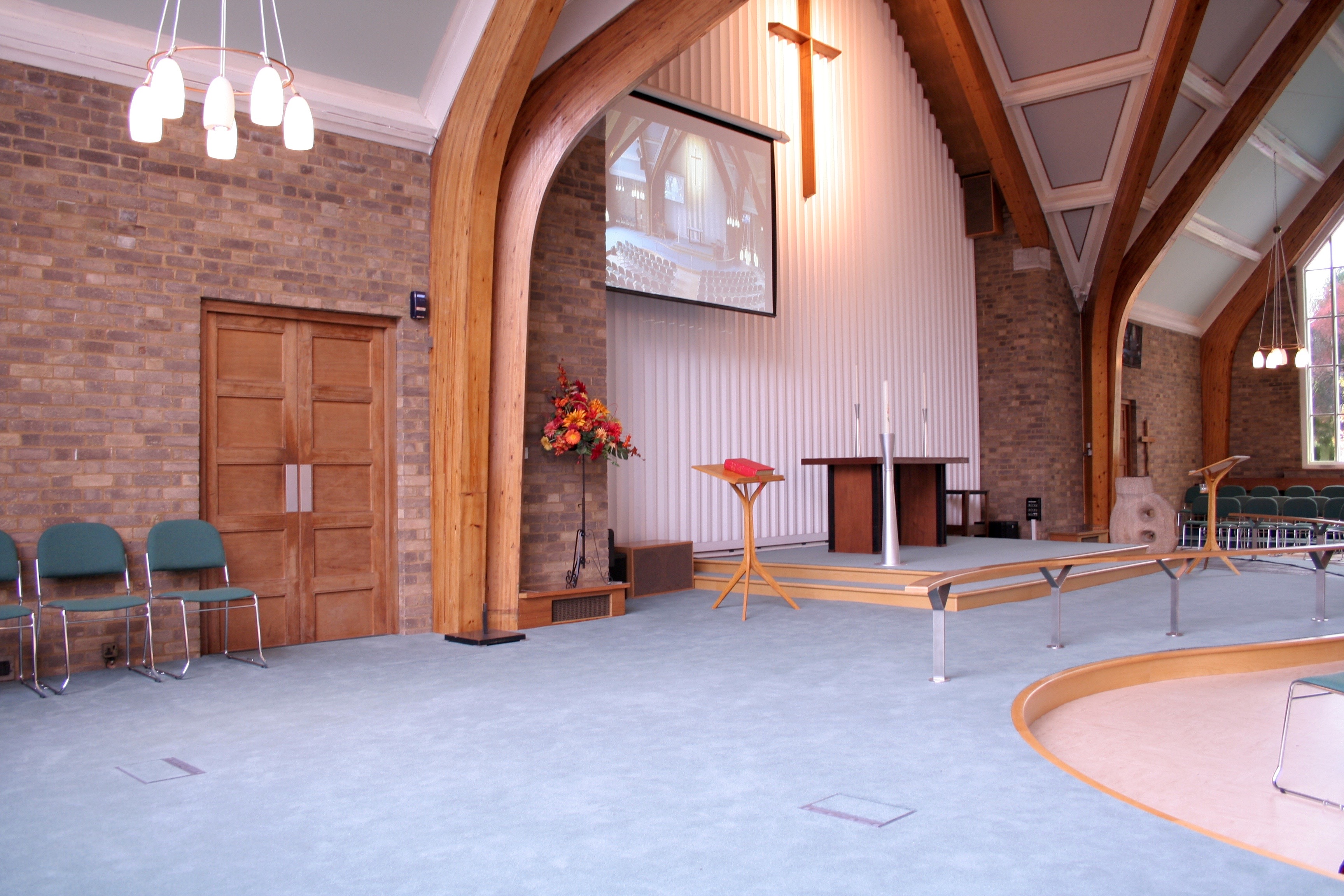 Newtech Southern was asked to submit a proposal for replacing the church video and audio system at the Church of the Good Shepherd in Surrey. After several meetings to ensure that the new system design was adequate to meet the needs of the church Newtech was awarded the contract to design, install and commission a new audio visual system.
Newtech Southern was asked to submit a proposal for replacing the church video and audio system at the Church of the Good Shepherd in Surrey. After several meetings to ensure that the new system design was adequate to meet the needs of the church Newtech was awarded the contract to design, install and commission a new audio visual system.
Yorkshire churches' artworks benefit from an expert touch
 Based in Harrogate, Everingham Conservation provides a high-quality service for the conservation and restoration of fine art and decorative surfaces. David Everingham trained at the University of Northumbria, where he gained an MA in the conservation of fine art.
Based in Harrogate, Everingham Conservation provides a high-quality service for the conservation and restoration of fine art and decorative surfaces. David Everingham trained at the University of Northumbria, where he gained an MA in the conservation of fine art.
New AV system helps church become community hub
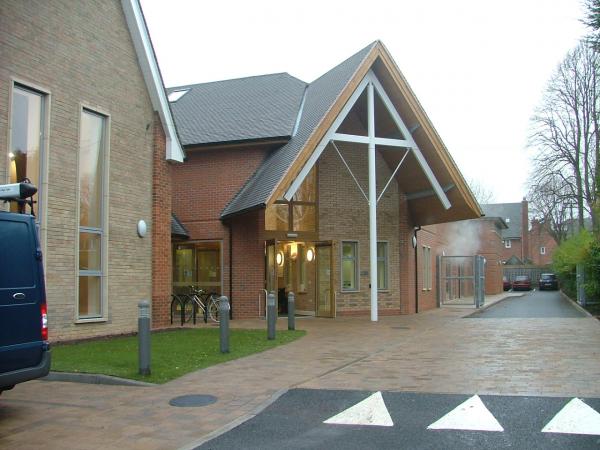
Churchgoers at Littleover Methodist Church near Derby are hoping their new £1.9m base will become a hub of the community. The renovated church boasts a new sports hall, cafe, two function rooms, a prayer room and dedicated pre-school area - as well as a tank for rain water harvesting.
On top of all this it also has a linked sound and AV system so that services can be heard in rooms throughout the building.
Historic clock paves the way for future expertise
 Turret clock and Harrison specialist, Chris McKay, last month worked alongside apprentices from clockmakers Smith of Derby to restore the James Harrison of Hull's clock which arrived at the company's Derby workshop on 22nd December.
Turret clock and Harrison specialist, Chris McKay, last month worked alongside apprentices from clockmakers Smith of Derby to restore the James Harrison of Hull's clock which arrived at the company's Derby workshop on 22nd December.
The preliminary analysis of the clock marks the first step towards a restoration which will see the piece reinstalled at the Derby Silk Mill as part of their renovation to become the Museum of Making 2020.














